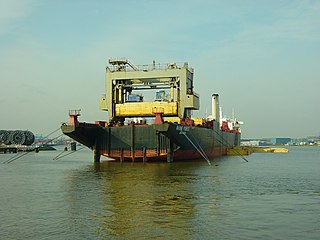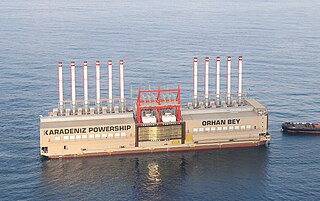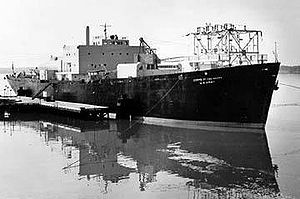
Barge often refers to a flat-bottomed inland waterway vessel which does not have its own means of mechanical propulsion. The first modern barges were pulled by tugs, but on inland waterways, most are pushed by pusher boats, or other vessels. The term barge has a rich history, and therefore there are many other types of barges.
The Ship-Submarine Recycling Program (SRP) is the process that the United States Navy uses to dispose of decommissioned nuclear vessels. SRP takes place only at the Puget Sound Naval Shipyard (PSNS) in Bremerton, Washington, but the preparations can begin elsewhere.

Otto Hahn was one of only four nuclear-powered cargo vessels built to date. Planning of a German-built trade and research vessel to test the feasibility of nuclear power in civil service began in 1960 under the supervision of German physicist Erich Bagge. Launched in 1964, her nuclear reactor was deactivated 15 years later in 1979 and replaced by a conventional diesel engine room. The ship was scrapped in 2009.

NS Savannah was the first nuclear-powered merchant ship. She was built in the late 1950s at a cost of $46.9 million and launched on July 21, 1959. She was funded by United States government agencies. Savannah was a demonstration project for the potential use of nuclear energy. The ship was named after SS Savannah, the first steamship to cross the Atlantic ocean. She was in service between 1962 and 1972 as one of only four nuclear-powered cargo ships ever built.

Liberty ships were a class of cargo ship built in the United States during World War II under the Emergency Shipbuilding Program. Though British in concept, the design was adopted by the United States for its simple, low-cost construction. Mass-produced on an unprecedented scale, the Liberty ship came to symbolize U.S. wartime industrial output.

Nuclear marine propulsion is propulsion of a ship or submarine with heat provided by a nuclear reactor. The power plant heats water to produce steam for a turbine used to turn the ship's propeller through a gearbox or through an electric generator and motor. Nuclear propulsion is used primarily within naval warships such as nuclear submarines and supercarriers. A small number of experimental civil nuclear ships have been built.
The Army Nuclear Power Program (ANPP) was a program of the United States Army to develop small pressurized water and boiling water nuclear power reactors to generate electrical and space-heating energy primarily at remote, relatively inaccessible sites. The ANPP had several accomplishments, but ultimately it was considered to be "a solution in search of a problem." The U.S. Army Engineer Reactors Group managed this program and it was headquartered at Fort Belvoir, Virginia. The program began in 1954 and had effectively terminated by about 1977, with the last class of NPP operators graduating in 1977. Work continued for some time thereafter either for decommissioning of the plants or placing them into SAFSTOR. The current development of small modular reactors has led to a renewed interest in military applications.

The lighter aboard ship (LASH) system refers to the practice of loading barges (lighters) aboard a bigger vessel for transport. It was developed in response to a need to transport lighters, a type of unpowered barge, between inland waterways separated by open seas. Lighters are typically towed or pushed around harbors, canals or rivers and cannot be relocated under their own power. The carrier ships are known variously as LASH carriers, barge carriers, kangaroo ships or lighter transport ships.
SM-1 was a 2-megawatt nuclear reactor developed by the American Locomotive Company (ALCO) and the United States Atomic Energy Commission (AEC) as part of the US Army Nuclear Power Program (ANPP) in the mid-1950s. The compact "package" reactor was designed to produce electricity and generate heat for remote military facilities. The first, the SM-1, served as the Army's primary training facility to train reactor operations personnel from all three services. In 1954, the Department of Defense placed the US Army in charge of all military nuclear power plants except those used for propulsion by the US Navy. The Army's Chief of Engineers established the US Army Engineer Reactors Group in April 1954, and decided to construct the SM-1 facility at the Corps of Engineers headquarters at Fort Belvoir, Virginia, about 18 miles south of Washington, D.C. About 800 personnel were trained on the SM-1 during its operational life, from 1957 to 1973. The power plant was shut down in March 1973, and is monitored within a "restricted access" section of the post. Inspectors enter the shut-down operations control room every decade or so. The Army plans to start demolition in 2020.

Floating nuclear power stations are vessels designed by Rosatom, the Russian state-owned nuclear energy corporation. They are self-contained, low-capacity, floating nuclear power plants. Rosatom plans to mass-produce the stations at shipbuilding facilities and then tow them to ports near locations that require electricity.

A floating nuclear power plant is a floating power station that derives its energy from a nuclear reactor. Instead of a stationary complex on land, they consist of a floating structure such as an offshore platform, barge or conventional ship.

MH-1A was the first floating nuclear power station. Named Sturgis after General Samuel D. Sturgis, Jr., this pressurized water reactor built in a converted Liberty ship was part of a series of reactors in the US Army Nuclear Power Program, which aimed to develop small nuclear reactors to generate electrical and space-heating energy primarily at remote, relatively inaccessible sites. Its designation stood for mobile, high power. After its first criticality in 1967, MH-1A was towed to the Panama Canal Zone that it supplied with 10 MW of electricity. Its dismantling began in 2014 and was completed in March 2019.

Akademik Lomonosov is a non-self-propelled power barge that operates as the first Russian floating nuclear power station. The ship was named after academician Mikhail Lomonosov. It is docked in the Pevek harbour, providing heat to the town and supplying electricity to the regional Chaun-Bilibino power system. It is the world’s northernmost nuclear power plant.

A powership is a special purpose ship, on which a power plant is installed to serve as a power generation resource.

SS Rebecca Lukens was a Liberty ship built in the United States during World War II. She was named after Rebecca Lukens, the owner and manager of the iron and steel mill which became the Lukens Steel Company of Coatesville, Pennsylvania.

The Type B ship is a United States Maritime Administration (MARAD) designation for World War II barges. Barges are very low cost to build, operate and move. Barges were needed to move large bulky cargo. A tug boat, some classed as Type V ships, could move a barge, then depart and move on to the next task. That meant the barge did not have to be rushed to be unloaded or loaded. Toward the end of World War 2, some ships that had not been completed in time for the war were converted to barges. US Navy barges are given the prefix: YWN or YW. Due to shortage of steel during World War II, concrete ship constructors were given contracts to build concrete barges, with ferrocement and given the prefix YO, YOG, YOGN. Built in 1944 and 1945, some were named after elements.
SS Thomas LeValley was a Liberty ship built in the United States during World War II. She was named after Thomas LeValley. She was transferred to the Army Transport Service (ATS) and later renamed Major General Walter R. Weaver after Major General Walter R. Weaver, a graduate of Virginia Military Institute that went on to serve in several prominent commands during World War I and World War II, in the United States Army Air Forces.

The James River Reserve Fleet (JRRF) is located on the James River in the U.S. state of Virginia at near Fort Eustis. James River Reserve Fleet, a "ghost fleet,", is part of the National Defense Reserve Fleet. The Reserve Fleet ships in storage, called "mothballed", that can be ready for use if needed. Many are awaiting scrapping due to the age or condition of the ship. Some ships are used for target practice or as artificial reefs. A few ships became museum ships and other sold to private companies. Ships can be readied for use in 20 to 120 days during national emergencies or natural disaster. The U.S. Department of Transportation's Maritime Administration (MARAD) provides oversight of the James River Reserve Fleet. For the United States Navy ships the United States Navy reserve fleets stored these ships and submarines.














